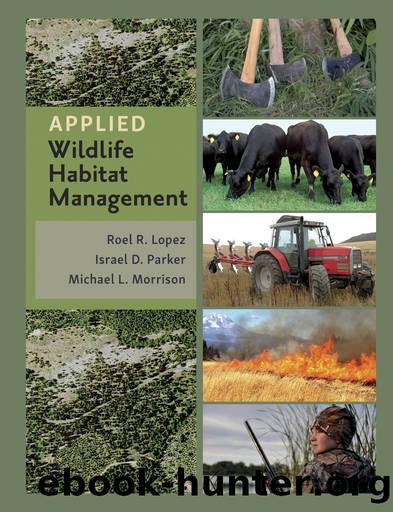Applied Wildlife Habitat Management by Roel R. Lopez Israel D. Parker & Michael L. Morrison

Author:Roel R. Lopez, Israel D. Parker & Michael L. Morrison [Lopez, Roel R.]
Language: eng
Format: epub
Publisher: Texas A&M University Press
Published: 2016-07-14T16:00:00+00:00
Source: Adapted from Seifres and Hamilton (1993); Volesky, Stubbendieck, and Mitchell (2007).
Table 4.5. Mechanical treatment cost checklist
Function and Benefits
There are many benefits to mechanical treatments used as an integral part of forest management, including (1) establishment of new forest stands, (2) increase of tree growth or biomass through the reduction of competition, (3) modification of forest composition through targeted species selection, and (4) improvement of overall forest health. Sustainable forestry often requires the active management of forest stands to ensure the successful reestablishment of plant communities following a harvesting operation. Forest activities that do not include reestablishment of preferred plant communities are considered logging rather than sustainable forestry. Mechanical treatments are critical to ensuring that these new forest stands are established through several approaches collectively referred to as regeneration systems (discussed in the implementation section). The benefit of these treatments is obviously the regrowth of preferred plant communities. For example, early-successional forest species like southern pines (Pinus spp.) require mechanical treatments that favor the species in reestablishment.
A second benefit of mechanical treatments is the reduction of both inter- and intra-plant species competition. Reduction of plant density serves to “release” favored tree species, resulting in increased growth or biomass/volume. This leads to an increase of merchantable tree volume (wood products). Mechanical treatments also modify forest composition through selectively targeting or favoring tree species and removing unwanted species. Finally, use of mechanical treatments maintains lower tree densities within a forest stand, which typically makes trees less susceptible to forest pests such as the southern pine beetle, because many forest pests and pathogens are density-dependent.
Application
Application of mechanical treatments is complex and dependent on set goals and manager experience. Managers ultimately want functioning ecosystems. For instance, midstory and understory mechanical treatments in forests are not designed to eliminate the midstory/understory. Generally, managers want a mixture of overstory, midstory, and understory in a sustainable state that benefits management goals (e.g., increased biodiversity, increased timber extraction). These mixtures can often be attained through a combination of different management options, including mechanical, herbicidal, and prescribed fire treatments. For example, spot herbicidal treatments might immediately follow mechanical removal of midstory trees to minimize regrowth. Mechanical treatment is also employed prior to some prescribed burns to increase burn efficacy or control. Managers must also consider season of treatment, location, and personnel experience/training. Applying mechanical treatment during multiple seasons can spread impact to different species at different times. This may improve management impact and success. Personnel experienced with heavy equipment and vegetation control can improve treatment impact, lower costs, and reduce time investments.
Planning
Proper forest planning is an important aspect of forest management. Many of the approaches used in modern-day forest management that include mechanical treatments are conducted within a general set of guidelines known as BMPs, introduced earlier in this chapter. These forestry guidelines are important to ensure the proper implementation of management activities to minimize potential negative environmental impacts. Most state forestry agencies, or federal entities if work is being conducted on federal lands, have forest BMPs available for land managers to consider during their planning processes.
Download
This site does not store any files on its server. We only index and link to content provided by other sites. Please contact the content providers to delete copyright contents if any and email us, we'll remove relevant links or contents immediately.
Sapiens: A Brief History of Humankind by Yuval Noah Harari(13036)
The Tidewater Tales by John Barth(12025)
Do No Harm Stories of Life, Death and Brain Surgery by Henry Marsh(6332)
Mastermind: How to Think Like Sherlock Holmes by Maria Konnikova(6224)
The Thirst by Nesbo Jo(5778)
Why We Sleep: Unlocking the Power of Sleep and Dreams by Matthew Walker(5636)
Sapiens by Yuval Noah Harari(4528)
Life 3.0: Being Human in the Age of Artificial Intelligence by Tegmark Max(4492)
The Longevity Diet by Valter Longo(4443)
The Rules Do Not Apply by Ariel Levy(3897)
The Immortal Life of Henrietta Lacks by Rebecca Skloot(3820)
The Body: A Guide for Occupants by Bill Bryson(3788)
Why We Sleep by Matthew Walker(3767)
Animal Frequency by Melissa Alvarez(3749)
Yoga Anatomy by Kaminoff Leslie(3696)
Barron's AP Biology by Goldberg M.S. Deborah T(3627)
The Hacking of the American Mind by Robert H. Lustig(3575)
All Creatures Great and Small by James Herriot(3506)
Yoga Anatomy by Leslie Kaminoff & Amy Matthews(3392)
